In the last group stage match of the Europa League, current Bundesliga leader Borussia Mönchengladbach was beaten by Istanbul Basaksehir which meant their early elimination from the European competition. For Basaksehir, on the other hand, the 2-1 win in the last minute secured them a spot within the round of the last 32 remaining teams.
In the following tactical analysis, we take a closer look at the tactics of both Gladbach and Basaksehir.
Lineups and formations
Marco Rose set Gladbach up in a 4-2-3-1 with Christoph Kramer and Denis Zakaria as the double pivot in front of the back-four.
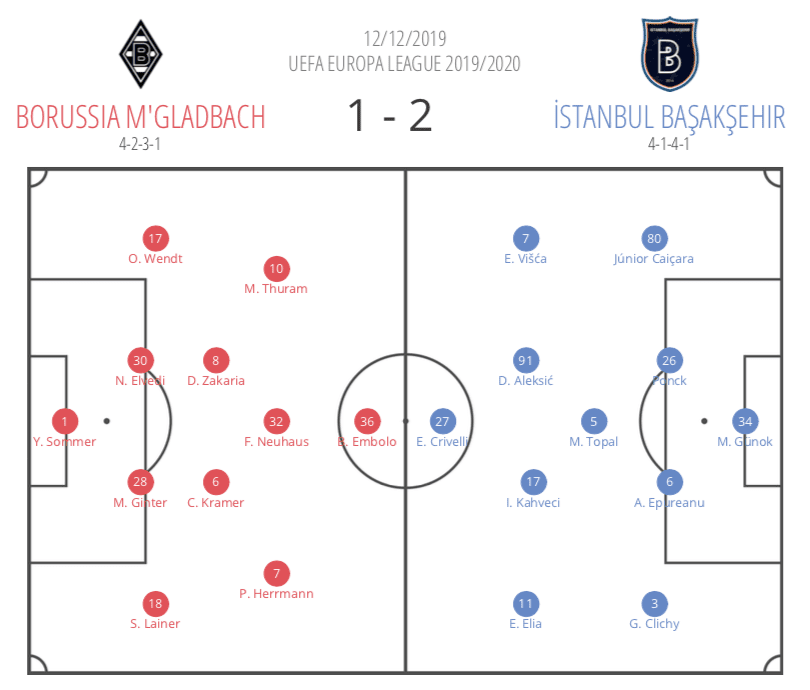
Basaksehir, on the other hand, deployed a 4-1-4-1 system with single pivot Mehmet Topal between two lines of four. Their advanced midfielders would enable Basaksehir to progress up the pitch through the half-spaces.
Gladbach’s fluid attacking approach
To defend, Gladbach set up in a 4-2-3-1 system. In possession, however, Gladbach utilised a fluid attacking approach with interchanges of positions. While the wingers Marcus Thuram (#10) and Patrick Herrmann (#7) positioned themselves between the opposition centre-back and full-back, Breel Embolo (#36) occasionally dropped into midfield.
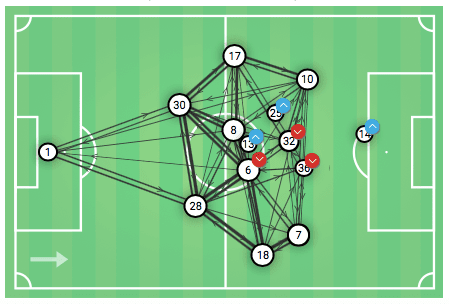
Advanced midfielder Florian Neuhaus (#32) freely roamed through the spaces between the opposition lines. Defensive midfielder Zakaria (#8) overtook different roles depending on the situation. Either he acted as a deep-lying midfielder or he moved onto the left wing to create an overload in a wide area. Kramer (#6) mostly structured Gladbach’s build-up play as a pivot in front of the central defenders.
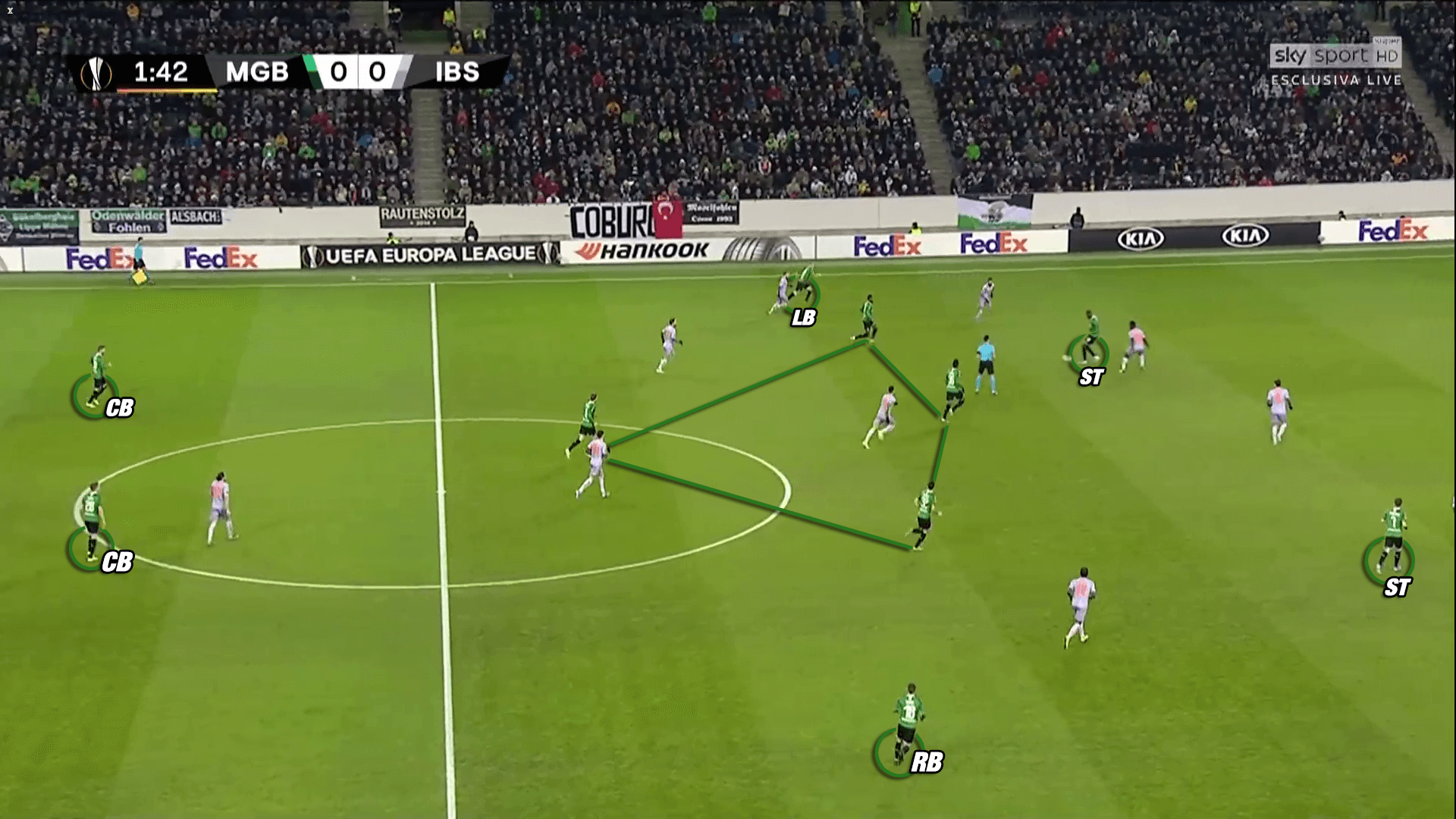
Their fluidity created different attacking shapes. As one can see above, one of these shapes is the 4-diamond-2 with the full-backs providing width while the centre is occupied by four players in midfield. This allowed Rose’s side to outnumber Basaksehir’s midfield three.
Since Gladbach’s centre-back pairing could build-up play against the opposition single striker, they were often offered much space to carry the ball into once having outplayed the attacker. Basaksehir’s midfielders moved out to press Gladbach’s centre-backs rather late which both enabled Rose’s side to progress up the pitch as well as their midfielders to get into positions between the lines.
Occasionally, the Turkish side would try to press Gladbach from the front. Therefore, their wingers would support the single striker while the advanced midfielders marked Gladbach’s midfielders. However, as their wingers had to press the central defenders, they had to leave the full-back free.
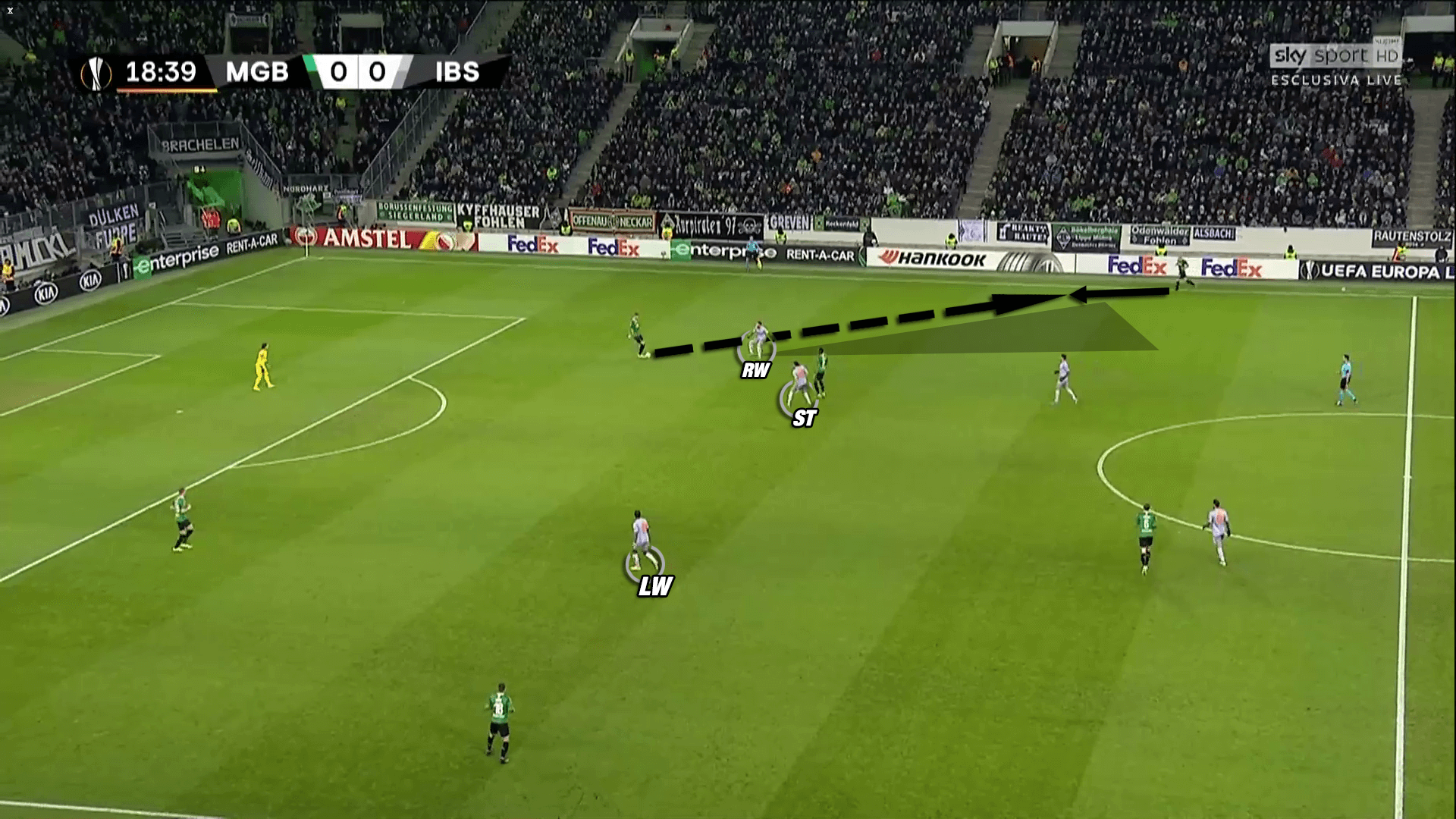
By moving out of the cover-shadow, Gladbach’s left-back could successfully offer an option to outplay the opposition press in the scenario shown above.
A common theme during Gladbach’s positional attacks was to overload one side of the pitch. Therefore, central defensive midfielder Zakaria would move into a wide area creating space for attackers Embolo or Thuram to drop into. Gladbach would then either quickly combine using the advantages of their overload or switch play and make use of the space on the other side of the pitch.
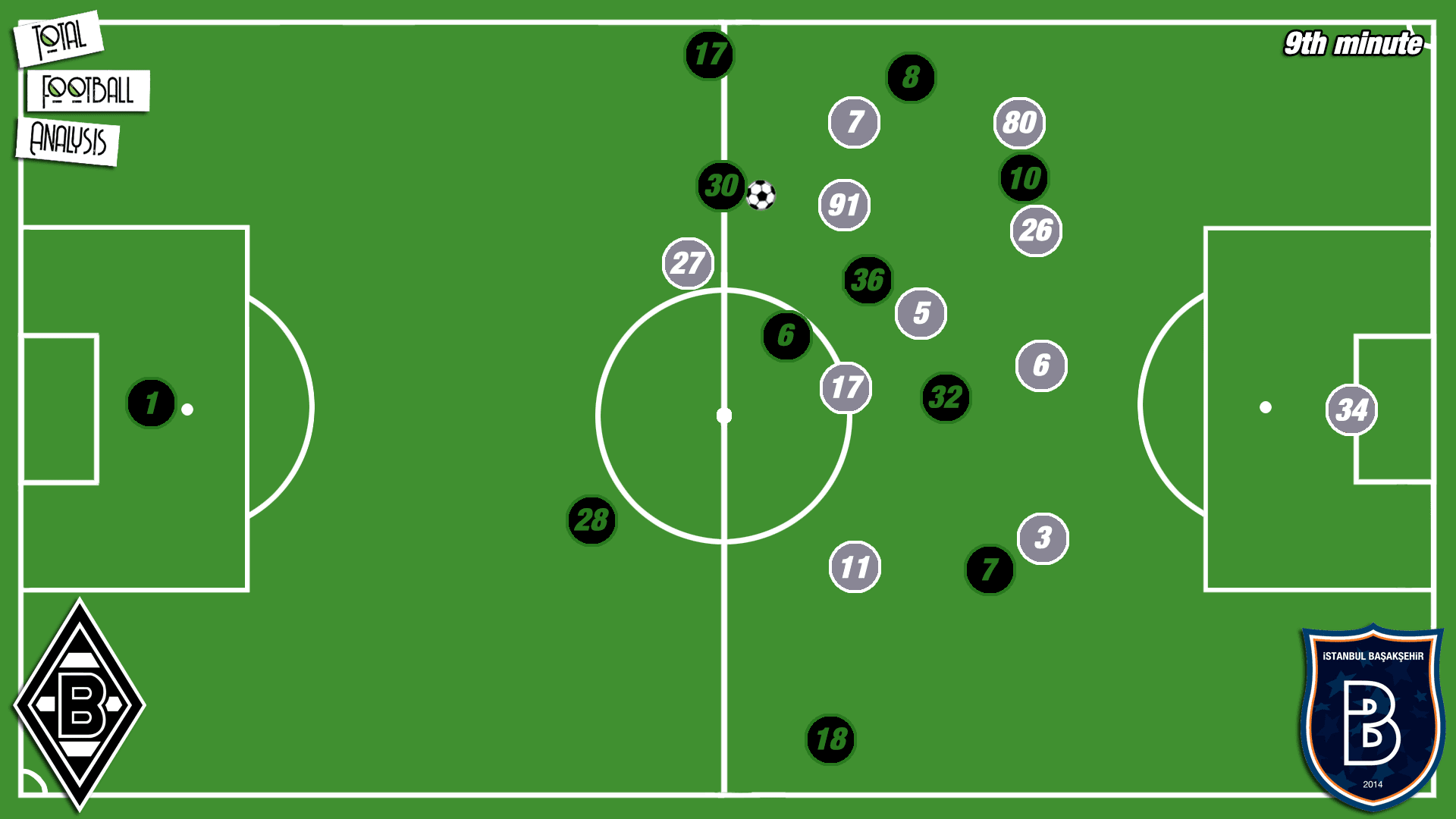
Gladbach pinned back the opposition back-four with their wide attackers being positioned between the central defender and the full-back (ball near, #10) or near to the full-back (ball far, #7). On the ball far side, Gladbach’s full-back (#18) was ready to move up the line in case of a switch of play.
By interchanging positions, Gladbach pushed Basaksehir’s block further towards the goal as they always followed the deep runs of Gladbach’s midfielders before communicating with their defenders for a takeover of the marking responsibilities. The biggest factor for a successful Gladbach attack was to force the opposition into a flat formation with more than just four players positioned within the backline. In these cases, Gladbach held the superiority in front of the backline and therewith ensured to gain second ball in Zone 14.
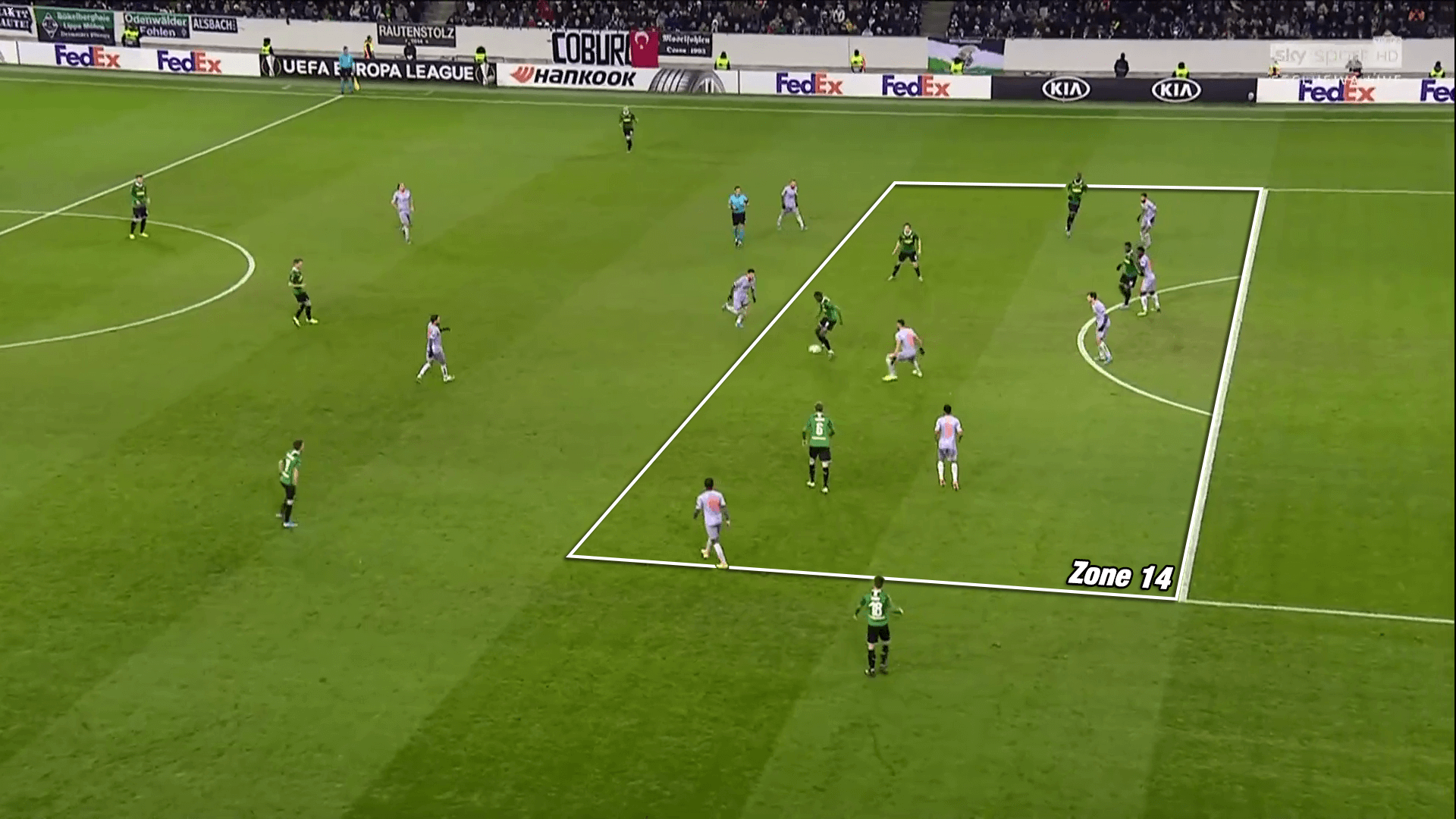
That way, Rose’s side scored the leading goal. A misplaced pass in Zone 14 immediately got back to a Gladbach player who played out wide. After a ground ball into the box, Gladbach then scored their only goal of the night.
Basaksehir’s half-space attacks
When being pressed within their own defensive third, Basaksehir did not risk to play out from the back with short passes. Due to their structure (see below), Basaksehir were limited to one side of the pitch and with a well-structured press, Gladbach could then force their opponent to hit the ball long. Throughout the whole game, Rose’s side averaged a PPDA value of 6.83 which underlines their intent to regain possession as soon as possible.
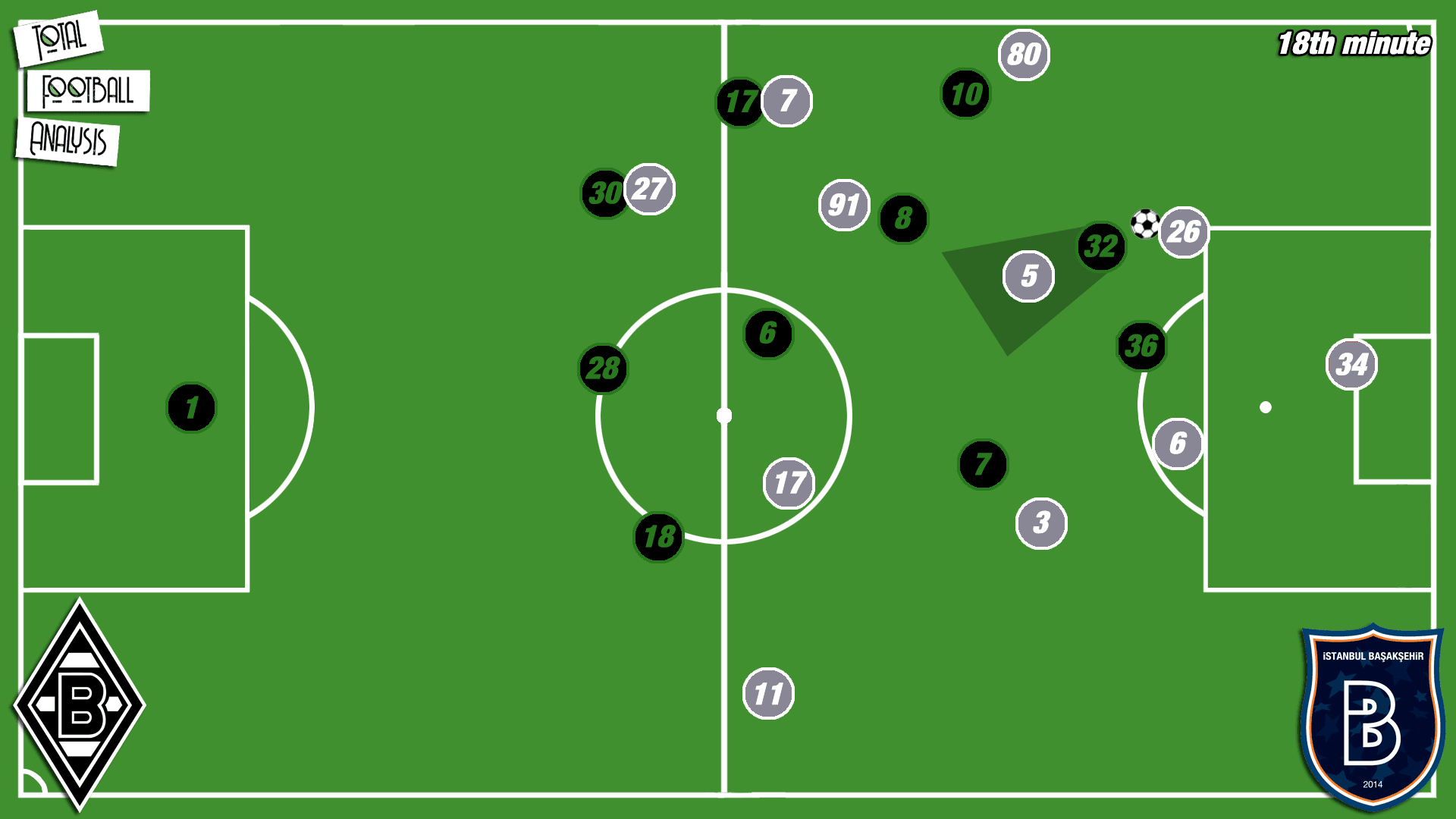
Therefore, advanced midfielder Neuhaus (#32) pressed the ball-carrying centre-back while keeping the opposition single pivot in his cover-shadow. Meanwhile, Breel Embolo (#36) prevented the opposition from switching sides. As Basaksehir’s ball far full-back tucked inside instead of providing width, this further decreased space. Both of Gladbach’s wingers marked the opposition full-backs. And since Gladbach’s double pivot took care of the two advanced midfielders, Basaksehir often had to hit the ball long to escape from their own half.
Whenever Basaksehir’s central defenders were offered more time and space on the ball though, they were able to play line-breaking passes into the half-spaces. Once having progressed up into the middle third, Basaksehir liked to position two players within the right half-space.
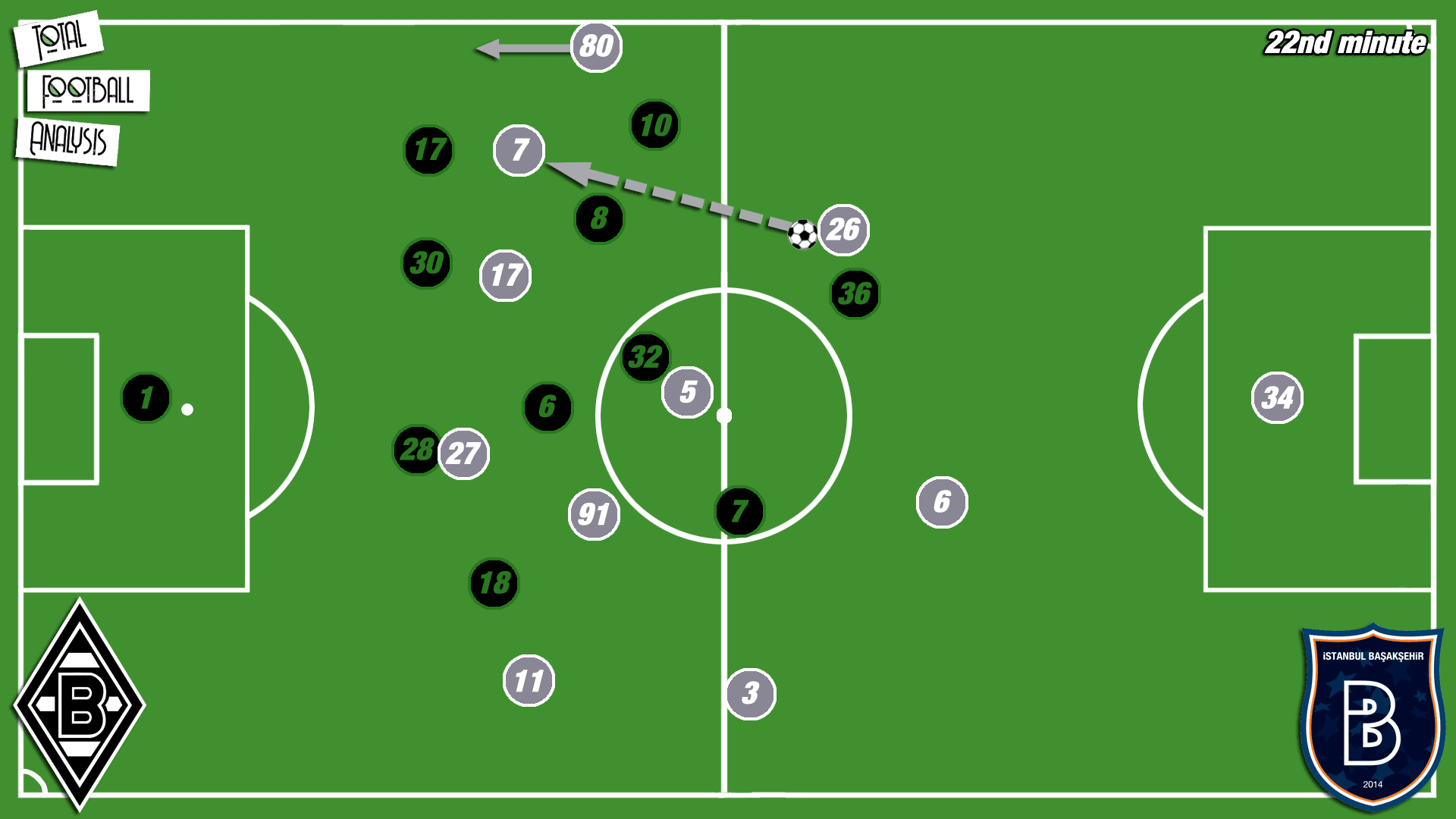
With these players being positioned behind Gladbach midfielder Zakaria on either side, the Swiss players was over challenged with closing down both of them. And as the back-four was occupied due to the opposition striker (#27) and the ball near full-back moving up the line (#80), the Turkish side could pass Gladbach’s midfield line that way.
Gladbach’s domination without outcome
Gladbach’s domination continued in the second half of the game.
Within the last third of the pitch, Gladbach made use of their striker positioning. As the attackers stayed within the opposition full-back and centre-back, this disabled Basaksehir’s full-backs to defend on the inner line.
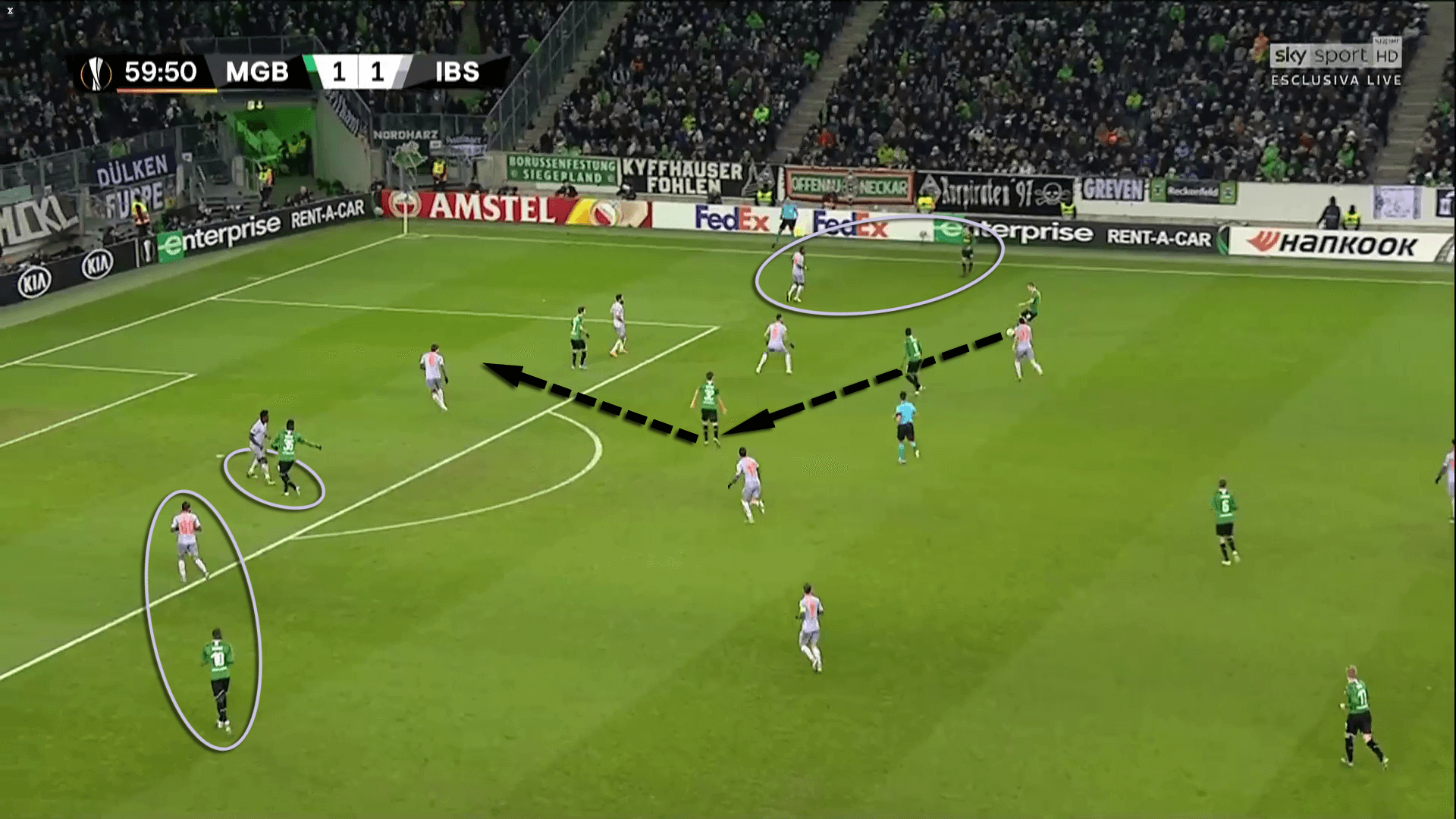
And because the central defenders did not want to be confronted with 1v1 situations, either of them defended space-oriented instead of marking the opposition attacker. This enabled Gladbach enough space to play through passes and break the last line of defence. But even these promising opportunities remained unused.
Gladbach were also offered more space especially after unsuccessful attempts of Basaksehir to press. This enabled Rose’s team to attack in numbers and quickly progress up the pitch through the vacated space in midfield.
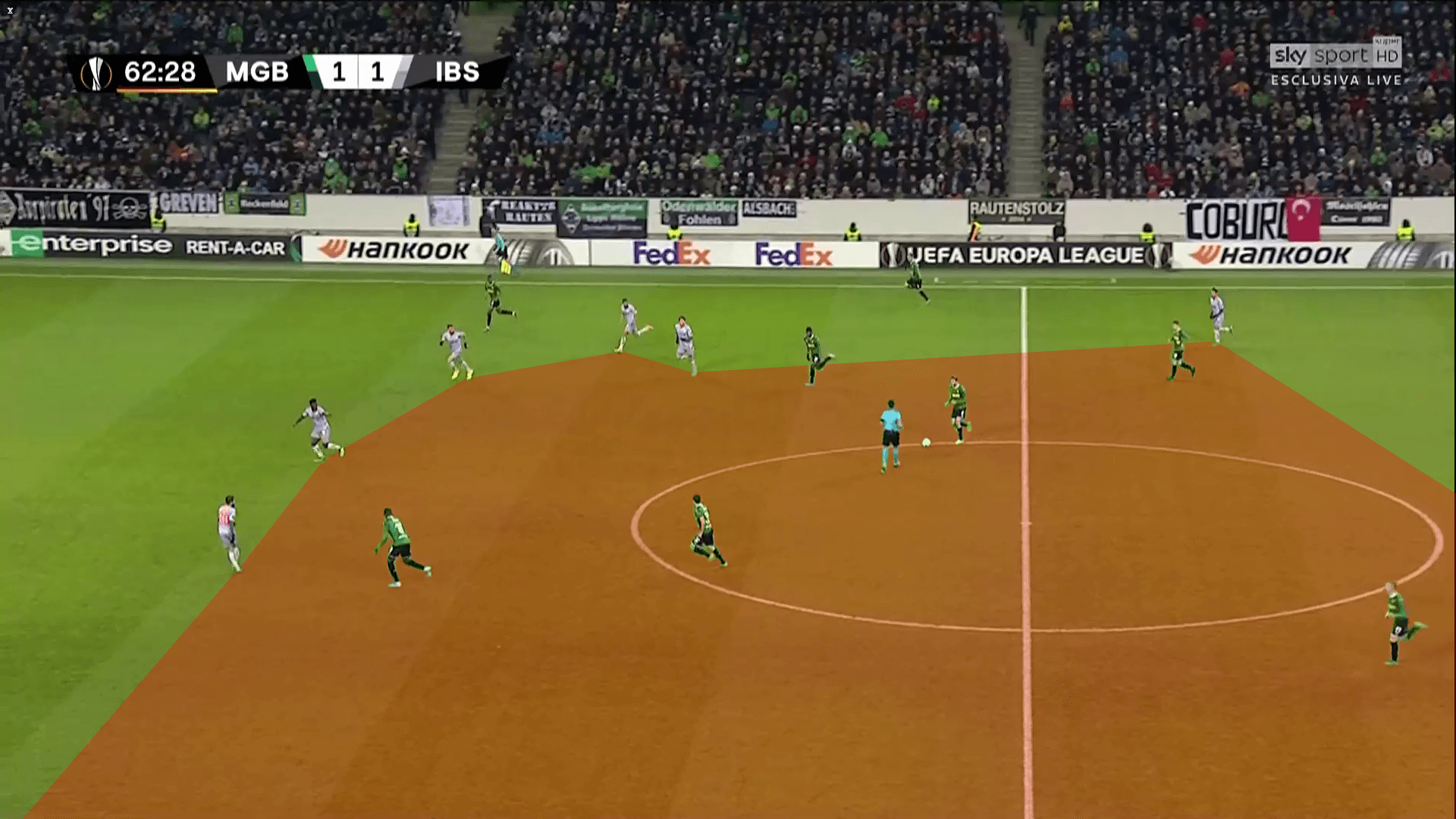
Nevertheless, often the last pass would miss accuracy and therewith mess up the whole attack.
Basaksehir’s change of formations
With their flat 4-1-4-1 formation which turned into a 4-5-1 or even into a 6-3-1 at times, Basaksehir often failed to retain possession after winning the ball. Gladbach’s counter-pressing was faster than Basaksehir’s wingers could move up the pitch to start a threatening counter-attack.
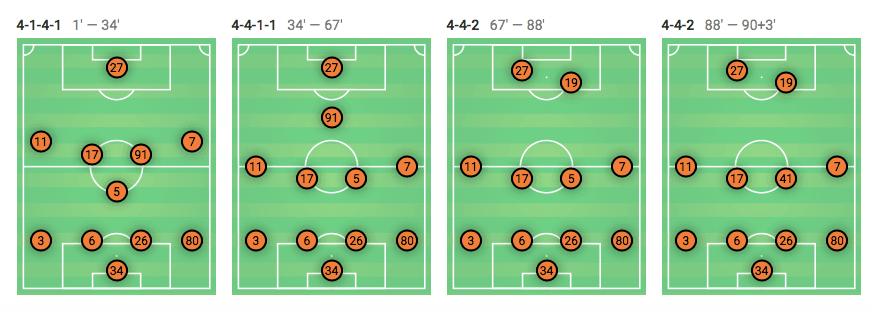
To change this, from the 67th minute on, Basaksehir played in a 4-4-2 formation with the intention to increase their attacking threat. The Turkish side were in need of a win to stay in the Europa League.
Due to their two-striker system, they had an additional player up front. Moreover, with their wingers attacking very narrow, Basaksehir aimed at creating a numerical equality against Gladbach’s back-four. And especially when they regained possession with a more aggressive press, their new system increased Basaksehir’s attacking threat. By sending in crosses, Basaksehir created chances as Gladbach’s defenders needed to defend man-to-man and could not create a numerical advantage fast enough.
Whenever Gladbach lost the ball higher up the pitch though, their midfield quickly got back behind the ball and closed down the central way towards the goal. And even in the last minute, their defensive transition phase seemed intact. They created a numerical superiority near the ball and were well prepared for defending a possible cross.
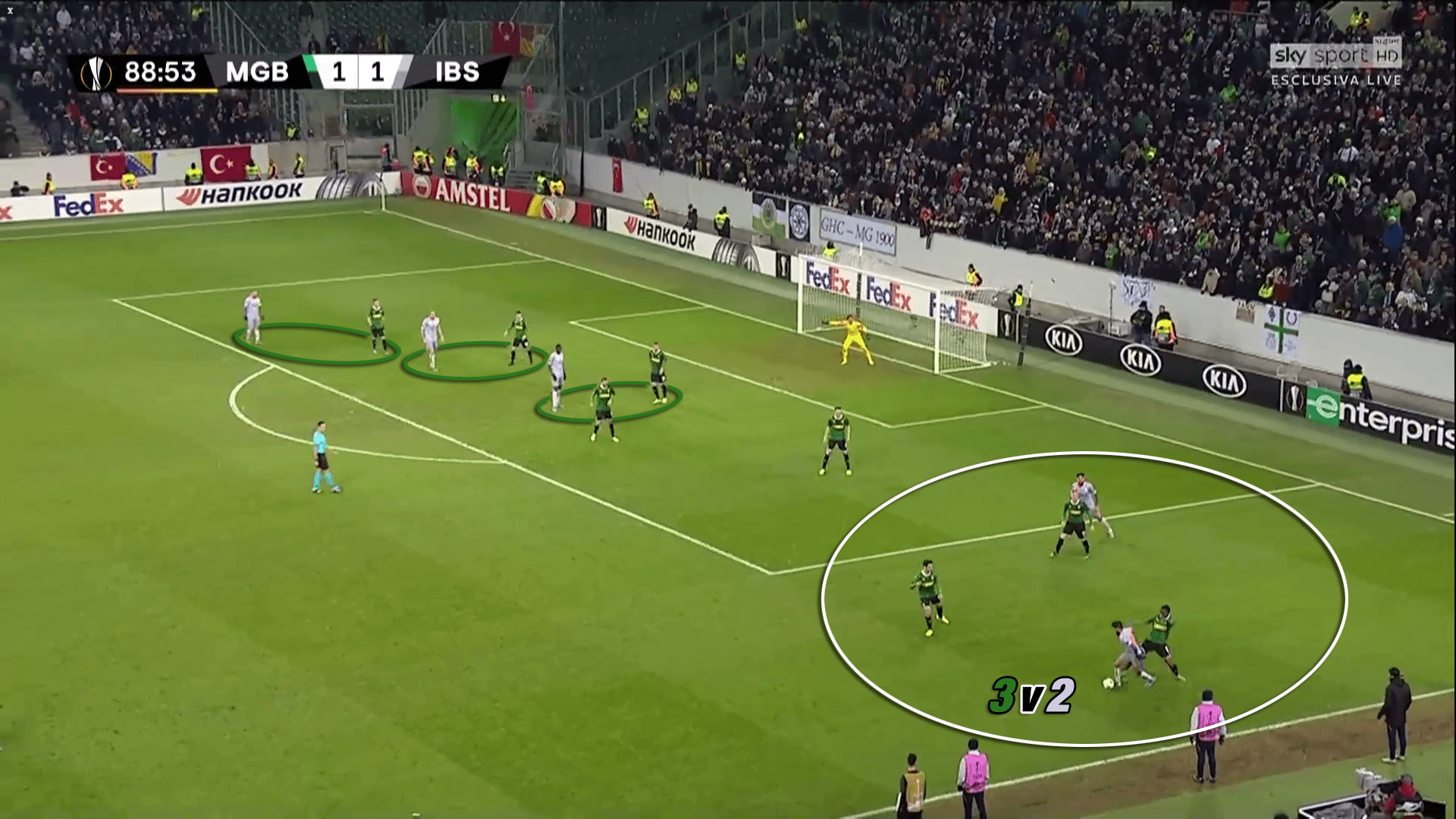
Nevertheless, an unnecessary foul caused a free-kick for Basaksehir. In the following of this set-piece situation, Gladbach lost their organisation when moving upfield again. As a consequence, Basaksehir took advantage of this and scored the winning goal.
Conclusion
Despite their dominance in all phases of the game shown in our analysis, Gladbach could neither score the winning goal nor defend a point. Although their attacking strategy worked out very well (3.11 xG), they missed the needed accuracy in the last third. And more importantly, they allowed Basaksehir an xG value of 1.78 which is more than is usual for Rose’s side.
All in all, the game between Gladbach and Basaksehir underlined the fact that tactics can increase the probability of success but do not guarantee the same.

If you love tactical analysis, then you’ll love the digital magazines from totalfootballanalysis.com – a guaranteed 100+ pages of pure tactical analysis covering topics from the Premier League, Serie A, La Liga, Bundesliga and many, many more. Buy your copy of the December issue for just ₤4.99 here





Comments